Reserve Bank of Australia Annual Report – 2015 Our People
The total number of Reserve Bank employees increased by 4 per cent during 2014/15. More than 80 per cent of the people who joined the Bank during the year were recruited on a limited-duration basis, largely to handle project work. The Bank continues to attract diverse and talented new employees through its graduate and cadetship programs.
Staff Profile
Over the year to June 2015, the total number of employees at the Reserve Bank (excluding Note Printing Australia Limited) increased by 4 per cent to 1,255. This is attributable largely to the continuation of major, multi-year projects that commenced in 2014 and which have required growth in employee numbers in the corporate service areas of the Bank in particular.
Of the 209 people who joined the Reserve Bank since July 2014, more than 80 per cent were recruited on a limited-duration basis, largely to handle the volume of project work at the Bank. Most of these new recruits were IT professionals. An important recruitment channel for the Bank continues to be the graduate and cadetship programs. During the year to June 2015, the Bank hired 33 graduates and 20 cadets (students in their final year of study who undertake vacation work at the Bank), representing one-quarter of all new employees. The new employees work in the Bank's policy, business and corporate service areas and hold degrees in economics, finance, accounting, law, science and other relevant disciplines.
During 2014/15, around 13 per cent of staff left the Reserve Bank. This is a slightly higher turnover rate than the Bank has experienced in the past and can largely be attributed to temporary staff leaving following the completion of various projects during the year. Such exits accounted for one-quarter of all departures. Given the high level of project-related work the Bank is currently undertaking, this trend is expected to continue over the next few years.

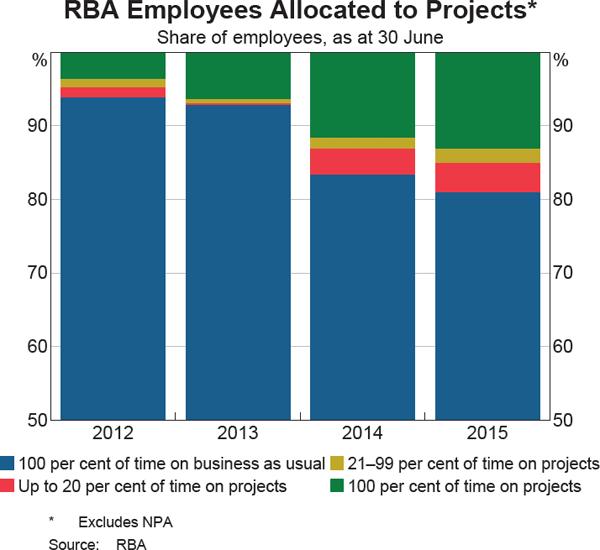
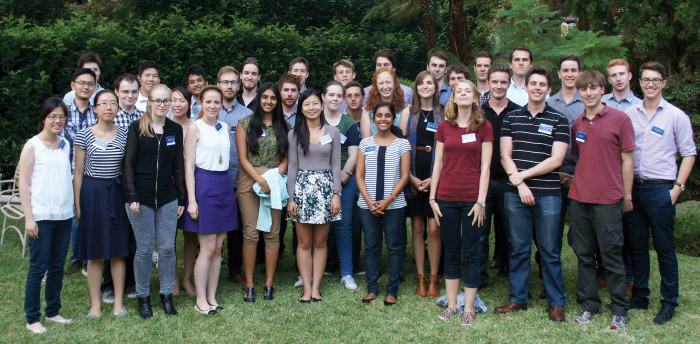
The Reserve Bank reviews its workforce diversity profile each year and reports on developments in its Equity & Diversity Annual Report. The Bank also has a Diversity Plan, which assists it in meeting its diversity and inclusion objectives by establishing key priorities every three years, as well as setting out the initiatives it will pursue to support those priorities. These priorities are determined through consultation with employees, workforce diversity profile analysis, and consideration of recent developments in diversity and inclusion practices. The Bank's current diversity and inclusion priorities are to:
- gain an understanding of the issues related to work-life balance that are important to employees and to use that information to contribute to equity and diversity policy deliberations and enhance workplace flexibility practices
- better understand the factors influencing the career experience of women
- achieve at least 35 per cent of female representation in management positions by 2020 and 40 per cent thereafter (discussed further below)
- continue improving the accessibility of the Bank's computing systems, information and building facilities for its employees and the community
- understand the needs of a maturing workforce and use that information to assist in workforce planning and knowledge retention.
Over the past decade, within a relatively stable diversity profile in the Reserve Bank overall, there has been an increase in the share of employees from a non-English speaking background and a decline in the share of employees with a disability.
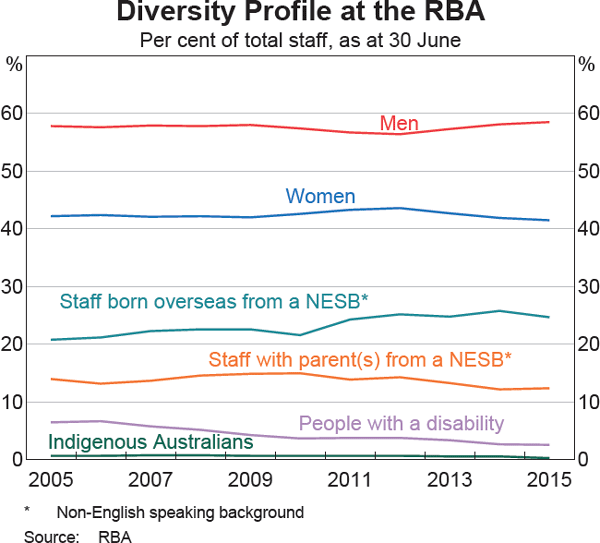
People and Culture
The Reserve Bank needs high-quality people working together productively to be able to fulfil its responsibilities. To support this, the Bank developed a multi-year strategy for People and Culture in 2013, which sought to:
- identify aspects of the Bank's culture and work environment that are our strengths, as well as areas in which we need to improve, and measuring our progress in making improvements
- develop a deep and diverse pool of well-trained potential leaders
- fully utilise the talents of our people
- foster an inclusive and flexible work environment.
The Reserve Bank has made steady progress in implementing its People and Culture strategy. During the past year, a new Diversity and Inclusion Policy was launched to help communicate the Bank's commitment to building a culture of diversity and inclusion, in which the contributions of people with different backgrounds, experiences and perspectives are both respected and utilised effectively. The policy sets out the Bank's objectives in this area, which are to provide equal opportunities for all employees and promote an inclusive and collaborative culture.
A key commitment made as part of this policy is to achieve an appropriate representation of women in management positions. To track progress, the policy introduced a gender target, which is for 35 per cent of management positions to be filled by women within five years, with a longer-term aim of 40 per cent. Women currently hold 32 per cent of management positions. When launching the new policy, the Reserve Bank also announced a range of gender-related initiatives it will pursue to support its target. Some of these initiatives are internally facing and aim to support women in the Bank, while others aim to promote economics, finance, mathematics and IT as career options for women in the community more broadly.
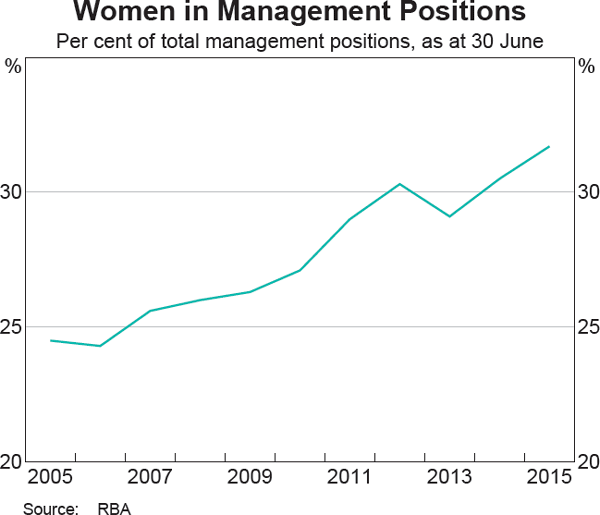
The Reserve Bank took the opportunity to review its performance management arrangements during the year to help support the objectives of the People and Culture strategy. This resulted in various changes to the overall framework and process in order to better align individual, team and organisational objectives while providing employees with clarity around the required standards of performance.
The People and Culture strategy places emphasis on ensuring that the talents of employees are being utilised and the Reserve Bank has a deep and diverse pool of well-trained potential leaders.
Making progress in leadership development is a priority of the People and Culture strategy. To support this, a mechanism was introduced for senior staff to obtain feedback from others on their leadership behaviours, which has helped to identify development opportunities that the Bank should provide. The Bank is also in the process of redeveloping its Leadership Development Program, with a focus on enhancing managers' abilities in the ongoing period of significant change. The objective of the program overall is to enhance the strategic leadership of management teams and at the same time emphasise participants' people-management skills, communication abilities and personal and professional development.
The Reserve Bank has a range of development opportunities for employees. While on-the-job training is an important component, this is supplemented by formal training programs, such as:
- a two-year Graduate Development Program, consisting of a range of tailored training programs to develop effective business writing, critical thinking, presentation and communication and negotiation skills. A total of 76 graduates are in this program for 2014/15
- programs supporting technical and professional development, including training in project management and IT change management
- training in management and leadership skills, as well as other general competencies, such as communication skills
- training in the Bank's compliance obligations, including in relation to work health and safety, fraud awareness and anti-money laundering and counter-terrorism financing.
The Reserve Bank provides development opportunities to employees by supporting secondments to other policy institutions in Australia and overseas. That is being replicated internally, with short-term staff secondments among different areas of the Bank. At the same time, the Bank has hosted secondees from the Department of the Prime Minister and Cabinet, Australian Prudential Regulation Authority, Australian Competition and Consumer Commission, Australian Treasury and Bank of England.
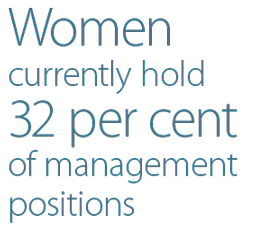
Financial support is provided to current employees for part-time study in disciplines related to their work, and around 57 employees studied part-time during 2014/15. In addition, each year the Reserve Bank provides support for full-time postgraduate study at universities in Australia and overseas; in December 2014, five employees were awarded such assistance.
The Reserve Bank also offers traineeships under the Australian Government's Apprenticeship Scheme. Designated positions are available to Aboriginal and Torres Strait Islander people, as well as people with disabilities and the long-term unemployed.
The Reserve Bank employed two Operations Assistants in 2015 through the Australian Government's Disability Employment Services initiative, Jobsupport, whose Open Employment Program places people with an intellectual disability into paid jobs in the regular workforce. The objective of this program is to place, train and maintain people with an intellectual disability in quality jobs that meet both their employment needs and the needs of the employer. Participation in this program provides the Bank with an opportunity to employ someone with an intellectual disability, give them a satisfying job and enhance their quality of life.
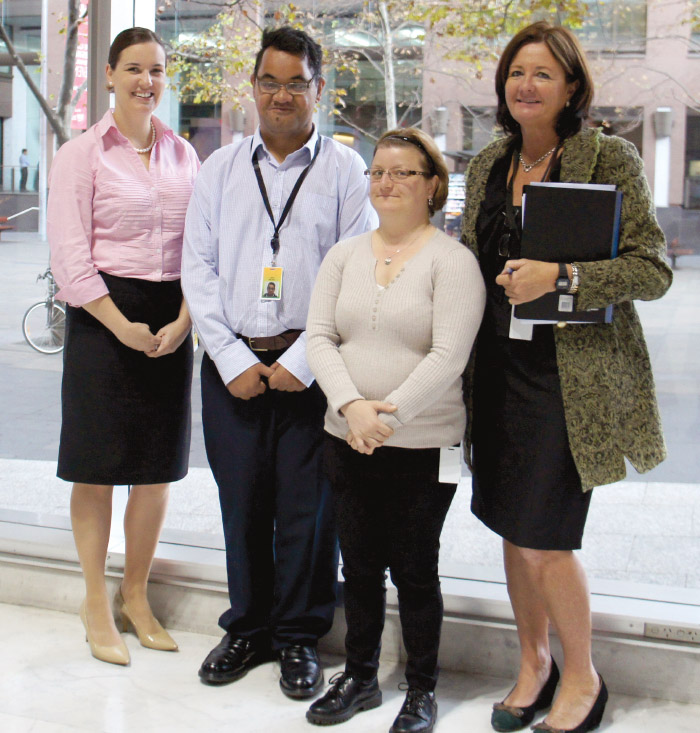
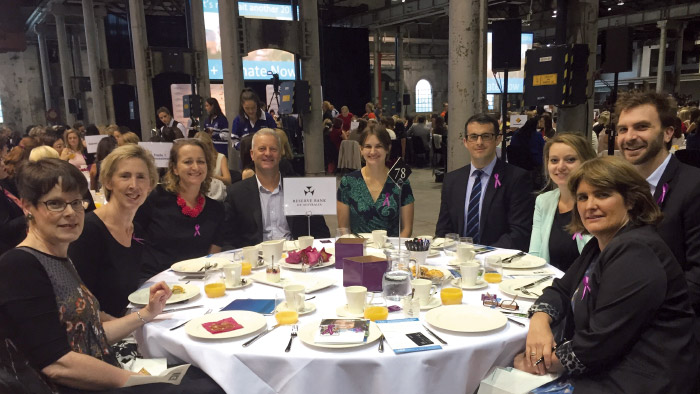
Workplace Agreement and Remuneration
In 2014/15, the Reserve Bank commenced negotiating a new Workplace Agreement. The Bank's objectives for the negotiations were to ensure that its working arrangements were consistent with contemporary standards and enabled the Bank to be an efficient and effective organisation.
While the negotiations were in progress, the 2014 remuneration review for employees was delayed, with adjustment being deferred pending an outcome on the Agreement. The Workplace Agreement negotiations took place in an environment in which the pace of pay gains in the general community had slowed significantly and the Government was requiring pay restraint in the public sector. It was the Reserve Bank's assessment that it could increase staff pay only if it was able to demonstrate efficiency improvements.
Despite a lengthy negotiation process, the Reserve Bank ultimately was not able to reach agreement with the Finance Sector Union. As a result, the Bank put the proposal directly to its employees in June 2015. This proposal included, among other things, freezing the bases of the salary bands, an increase in standard working hours, arrangements to facilitate 24/7 operations and a mechanism to better align salary outcomes with individual employee performance. A majority of employees accepted the proposed Agreement in July and it came into effect on 11 August 2015.